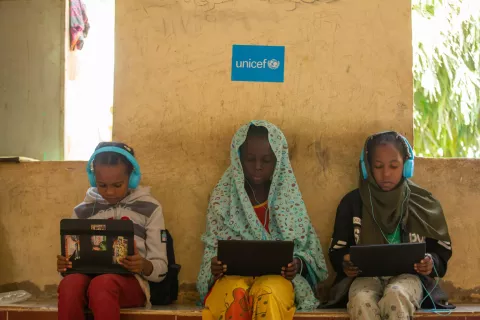Helping students in India make up for lost time
Alternative education programmes help children catch up after COVID-19 school closures.

KALAHANDI, India – “Children have completely forgotten what they learned two years ago,” says Jagadish, a teacher from Kalahandi, a rural area in the Indian state of Odisha. “And it’s sad to see how they are so scared to come to my centre now.”
A devastating second wave of COVID-19 in the first half of 2021 forced schools across India to close, affecting the learning of more than 280 million children. Some schools moved to online learning, but students without access to the internet were cut-off. Anganwadis – early childhood development centres in rural areas – also closed, leaving millions of children in rural areas without access to early education.
As the number of COVID-19 cases have plateaued, schools have started to reopen, but the accumulated effects of children being out of classrooms for so long has been a challenge. Fears of a potential third wave are also complicating efforts to get children learning again.
“It’s difficult to get children motivated again. They seem to have lost interest,” Jagadish says.
Jagadish is a trainee on the Alternative Internship Programme, a three-month internship launched by the State of Odisha to help bridge digital and learning gaps in the state. By the first week of October, the initiative had engaged almost 9,000 trainee teachers and reached more than 75,000 students.
Jagadish currently teaches 40 children in three groups, with a focus on activity-based teaching involving games, singing, dancing and other fun activities to help children feel more engaged in class after such a long absence. “We’re trying to get them excited about learning,” he says. “Hopefully this will help reduce their fear of schools.”
Safety first
Jagadish has also taken his passion for helping children learn directly to parents, going door-to-door to encourage them to send their children to learning centres that are part of the programme. The centres, which are free for children to attend, also follow COVID-19 safety precautions including physical distancing, regular handwashing and the use of face masks.
“Physical distancing limits teacher-child interaction. But we are trying to figure our way around it,” Jagadish says, adding that gaining the confidence of children who have missed out on school for so long is a real challenge.
But for Neha, a girl attending one of Jagadish’s classes, the effort seems to be paying off.
“I was really sad because school was closed for too long. Now I feel very happy attending these fun classrooms with so many games and activities like singing and dancing,” she says. “I also love seeing my friends again.”
Flexible thinking
Monika Nielsen, UNICEF’s field office chief in Odisha, says that unequal access to internet-based learning has required different approaches to reaching students who risk being left behind, including the Alternate Learning Programme, which UNICEF has partnered on. She says the programme has been a small but positive step, particularly for the most vulnerable families in the state. The programme “took lessons to the poorest and most vulnerable students, bringing back the joy of learning to both students and trainee teachers,” she says.
Gourimani, a trainee teacher from Mayurbhanj, a village in Odisha, says she is excited to see so many parents enrolling their children in the programme. But she says that ensuring children are making the most of the classes requires a flexible approach to teaching.

“It’s a tribal area, so many children cannot fully understand the state language, Odia, and are more comfortable with their mother tongue, Santali,” Gourimani says.
There are more than 60 tribal communities in the state that between them speak at least 21 tribal languages, according to 2011 census data. Many of these languages – including Santali – have their own scripts, posing a unique challenge for education initiatives.
“I started out teaching in Odia without realizing this,” she says. “I noticed many children dropping out. That’s when I decided to customize the classes in Santali.”
Gourimani has developed a range of teaching materials in Santali, translating them from the official Odia curriculum. Gourimani’s mother, inspired by her daughter’s dedication, has also been helping out. The duo has worked hard to create an inspiring learning centre and their efforts have caught the eye of some programme mentors.
“When you see her learning centre, you realize how talented she is. It’s excellent work she has done here,” says Dr Purna Chandra Brahma, Gourimani’s programme mentor. “The personal initiatives she and her mother have taken are really motivating.”




